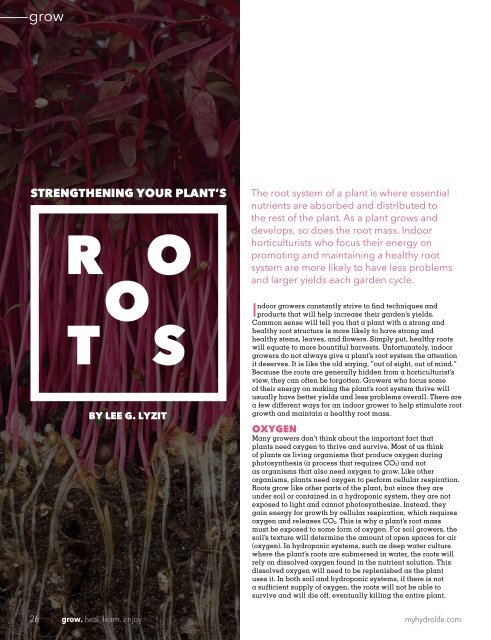Hydrolife Magazine June/July 2017 (USA Edition)
Marijuana, be it medicinal or recreational, still has a long way to go to shake the stigma it has endured for decades in North America. It continues to be an industry struggling to capture acceptance and credibility despite its recent progress. This reality is perhaps just one of the reasons why losing Strain Hunter Franco Loja to cerebral malaria in January.
Marijuana, be it medicinal or recreational, still has a long way to go to shake the stigma it has endured for decades in North America. It continues to be an industry struggling to capture acceptance and credibility despite its recent progress. This reality is perhaps just one of the reasons why losing Strain Hunter Franco Loja to cerebral malaria in January.
Create successful ePaper yourself
Turn your PDF publications into a flip-book with our unique Google optimized e-Paper software.
grow<br />
STRENGTHENING YOUR PLANT’S<br />
R O<br />
O<br />
T S<br />
BY LEE G. LYZIT<br />
The root system of a plant is where essential<br />
nutrients are absorbed and distributed to<br />
the rest of the plant. As a plant grows and<br />
develops, so does the root mass. Indoor<br />
horticulturists who focus their energy on<br />
promoting and maintaining a healthy root<br />
system are more likely to have less problems<br />
and larger yields each garden cycle.<br />
Indoor growers constantly strive to find techniques and<br />
products that will help increase their garden’s yields.<br />
Common sense will tell you that a plant with a strong and<br />
healthy root structure is more likely to have strong and<br />
healthy stems, leaves, and flowers. Simply put, healthy roots<br />
will equate to more bountiful harvests. Unfortunately, indoor<br />
growers do not always give a plant’s root system the attention<br />
it deserves. It is like the old saying, “out of sight, out of mind.”<br />
Because the roots are generally hidden from a horticulturist’s<br />
view, they can often be forgotten. Growers who focus some<br />
of their energy on making the plant’s root system thrive will<br />
usually have better yields and less problems overall. There are<br />
a few different ways for an indoor grower to help stimulate root<br />
growth and maintain a healthy root mass.<br />
OXYGEN<br />
Many growers don’t think about the important fact that<br />
plants need oxygen to thrive and survive. Most of us think<br />
of plants as living organisms that produce oxygen during<br />
photosynthesis (a process that requires CO 2) and not<br />
as organisms that also need oxygen to grow. Like other<br />
organisms, plants need oxygen to perform cellular respiration.<br />
Roots grow like other parts of the plant, but since they are<br />
under soil or contained in a hydroponic system, they are not<br />
exposed to light and cannot photosynthesize. Instead, they<br />
gain energy for growth by cellular respiration, which requires<br />
oxygen and releases CO 2. This is why a plant’s root mass<br />
must be exposed to some form of oxygen. For soil growers, the<br />
soil’s texture will determine the amount of open spaces for air<br />
(oxygen). In hydroponic systems, such as deep water culture<br />
where the plant’s roots are submersed in water, the roots will<br />
rely on dissolved oxygen found in the nutrient solution. This<br />
dissolved oxygen will need to be replenished as the plant<br />
uses it. In both soil and hydroponic systems, if there is not<br />
a sufficient supply of oxygen, the roots will not be able to<br />
survive and will die off, eventually killing the entire plant.<br />
26 grow. heal. learn. enjoy.<br />
myhydrolife.com




![Hydrolife Magazine December 2017/January 2018 [CANADIAN EDITION]](https://img.yumpu.com/59790088/1/190x247/hydrolife-magazine-december-2017-january-2018-canadian-edition.jpg?quality=85)
![Hydrolife Magazine December 2017/January 2018 [USA EDITION]](https://img.yumpu.com/59790042/1/190x247/hydrolife-magazine-december-2017-january-2018-usa-edition.jpg?quality=85)
![Hydrolife Magazine October/November 2017 [Canada Edition]](https://img.yumpu.com/59493562/1/190x247/hydrolife-magazine-october-november-2017-canada-edition.jpg?quality=85)
![Hydrolife Magazine October/November 2017 [USA Edition]](https://img.yumpu.com/59493548/1/190x247/hydrolife-magazine-october-november-2017-usa-edition.jpg?quality=85)
![Hydrolife Magazine August/September 2017 [USA Edition]](https://img.yumpu.com/59236656/1/190x247/hydrolife-magazine-august-september-2017-usa-edition.jpg?quality=85)








